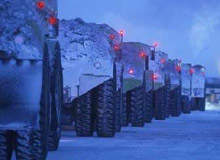
The Northstar oil field is nearing completion and will be the first operational oil field in Alaska. It was discovered by Shell in 1983 and although Shell and Amerada carried out appraisals of the field by drilling five wells, the estimated cost of $1.5 billion prohibited further development. After acquiring the interests in the field in 1995, BP is now in a position to make development of the field economically viable. It is currently owned by Exploration (Alaska) Inc. (98%) and Murphy Oil Co. (2%).
NORTHSTAR OIL FIELD DEVELOPMENT
The field is believed to hold around 176 million barrels of recoverable oil. Extraction should start in late 2001 and have a life of around 15 years, making it a smaller but still significant project. Output is expected to peak at 65,000 barrels per day.
The 38,400 acre reservoir is being developed from a man-made island off the north coast of Alaska called Seal Island, which has been expanded to five acres. A total of 16 producing wells, five gas injectors, and one waste disposal well (22 total) are planned and there is space for up to 36 drilling wells. Around 1,300t of offshore facilities are also planned for Northstar, including three 9,600kW turbine driven generators to supply electricity to the island, and two 32,000hp turbine-driven natural gas compressors for re-injection of gas into the reservoir.
The oil will be taken to the mainland via a pipeline with onshore and offshore sections. It reaches shore near Point Storkerson, from where the pipeline continues to the Trans-Alaska pipeline. The offshore portion is buried well below ice gouge depths and protected by corrosion and leak-detection systems. BP has also built a 16.3 mile long gas pipeline from the Central Compressor Plant in the Prudhoe Bay field to the Northstar production facility. Gas from the Prudhoe Bay field will be injected into the Northstar reservoir to enhance oil recovery and used to provide fuel gas for Seal Island operations.
NORTHSTAR OIL FIELD ENVIRONMENTAL ISSUES
The Bush administration has come under great criticism for its plans to increase oil production to alleviate America’s energy shortage. President Bush has placed Alaska near the top of his list of areas with as yet untapped oil reserves. This is likely to lead to serious opposition in Congress, as the area is of great concern to environmentalists. The Sierra Club has described the area as “one of the only places left in the Arctic where wildlife has been growing and changing for thousands of years in a continuous natural cycle.” The organisation disagrees with oil companies that it is possible to have environmentally friendly oil extraction.
The area shields polar bears, grizzlies, musk oxen, wolves and moose, in addition to providing a critical calving site for the 150,000 caribou of the porcupine herd that migrate as far as 800 miles from Canada each year. A marine biologist has described the area as one of the two most important wetlands of the world. The region’s Copper River, which is also the subject of a proposal for a drilling operation, is home to two million salmon. An oil spill in this region could spell disaster for these wildlife. The Exxon Valdez oil spill in nearby Prince William sound caused the collapse of herring and pink salmon in 1989.
Nevertheless, BP seems confident that it is taking the environmental issue sufficiently seriously. It has been undertaking seal surveys in conjunction with the National Marine Fisheries Service which will continue for three years after the plant’s completion. Before ice roads have been constructed, it conducted searches for breathing holes, resting areas and other areas of seal activity. Drilling and barge traffic have been restricted to months when whale movements are at their lowest. Steps have also been taken to minimise impact to polar bears, water-foul, sea ducks and shore birds.

